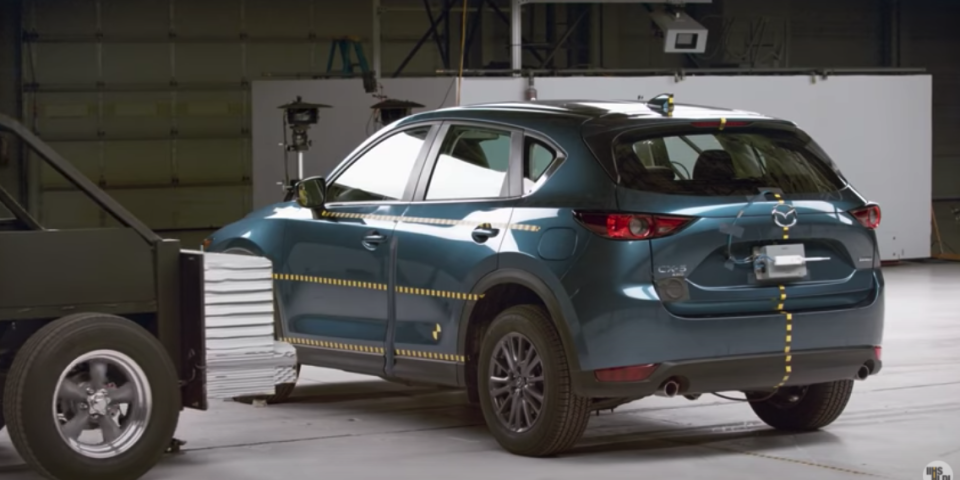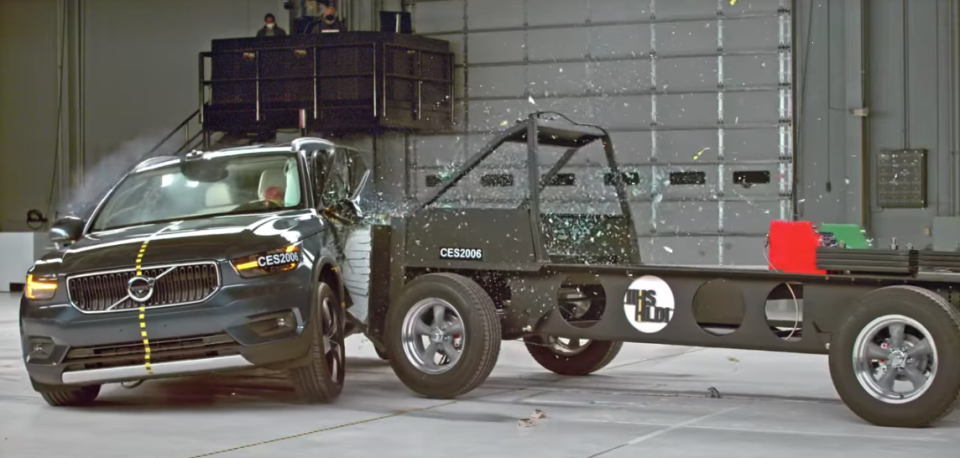Small SUVs Have Room to Improve in IIHS's New Side-Impact Crash Test

High-speed side impacts were responsible for 23 percent of passenger vehicle occupant deaths in 2019, according to the Insurance Institute for Highway Safety (IIHS), so the nonprofit safety organization decided to update its 2003 side-impact test.
IIHS now uses a heavier barrier moving at higher speeds to strike the vehicle being tested—an 82 percent increase in overall energy—to better represent common crashes today.
Only one small SUV, the Mazda CX-5 (pictured above), earned the top Good rating, while the Honda HR-V and Mitsubishi Eclipse Cross were rated Poor.
The good news is that the Insurance Institute for Highway Safety (IIHS) recently ran 20 small SUVs through a new series of more stringent crash tests that were designed to better model a high-speed side impact. The bad news is that none of the vehicles tested in one of the most popular vehicle segments in the U.S. scored a "good" rating, the highest possible, in all categories.
IIHS changed the way it tests side impact crashes by using a heavier barrier moving at a higher speed—it's now 4180 pounds at 37 miles per hour, compared to 3300 pounds at 31 mph in the earlier test protocol, for an increase of 82 percent more energy overall. That change is to better simulate the not-that-uncommon incident of a mid-size SUV hitting a small SUV.
IIHS said it also updated the honeycomb striking surface of the new barrier so that it "acts more like a real SUV or pickup when it hits another vehicle." In the real world, IIHS discovered that a strong B-pillar, which was important for the old side-impact test, could bend the striking vehicle's front end, and those bent areas could intrude into the passenger cabin. IIHS said automakers will probably have to improve the strength of the horizontal door beams to provide better occupant protection. That will also let them get better scores in the new IIHS test.
The only small SUV to come close to a perfect score was the 2021 and 2022 Mazda CX-5, which aced all the categories except the chest category for driver injuries. There, the CX-5 was rated Acceptable, the second-highest score. Mazda's Masaki Ueno, vice president of R&D, design, and quality assurance, said in a statement that the company studied real-world crashes and computer simulations as it designed the CX-5's body structure and load paths.
IIHS gave almost half of the vehicles tested, nine out of 20, an overall Acceptable rating: Audi Q3, Buick Encore, Chevrolet Trax, Honda CR-V, Nissan Rogue, Subaru Forester, Toyota RAV4, Toyota Venza, and Volvo XC40. Two models, the Honda HR-V and the Mitsubishi Eclipse Cross, scored Poor ratings overall. The other eight—Chevrolet Equinox, Ford Escape, GMC Terrain, Hyundai Tucson, Jeep Compass, Jeep Renegade, Kia Sportage, and Lincoln Corsair—were given Marginal ratings. Full test information, including for this new side-impact crash test, is shown for each vehicle on the IIHS website under "Side: New Test."

IIHS claims high-speed side-impact crashes are behind 23 percent of passenger-vehicle occupant deaths in 2019, so it wanted to know which small SUVs provide the best protection in this situation.
"We developed this new test because we suspected there was room for more progress, and these results confirm that," IIHS president David Harkey said in a statement. "The good rating for the CX-5 shows that robust protection in a more severe side crash is achievable."
IIHS has a case to make that its tests can have an impact on how automakers design vehicles. The company introduced its first side-impact test in 2003, and rated only around 20 percent of the vehicles it tested as "good" that first year. Today, all 20 of the vehicles that were run through this new test earned "good" ratings on the original test, and IIHS said most new vehicles can earn a top score for this test.
Car companies have a short amount of time to adapt to the new test. For now, IIHS will continue to use the original test when it hands out its Top Safety Pick awards, but the award criteria will be updated in 2023 to reflect the new side test.

You Might Also Like

 Yahoo Finance
Yahoo Finance 